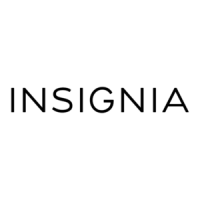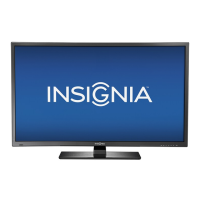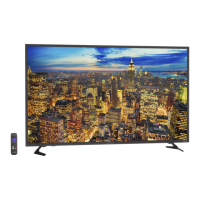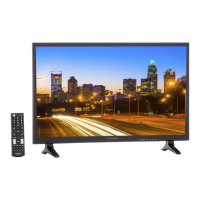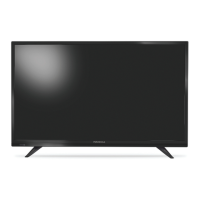What is the default password for Insignia NS-42L260A13A parental controls if I lost it?
- MMichelle GordonSep 23, 2025
If you've lost the password for parental controls on your Insignia TV, enter 9999 to access them and then set a new password.





What is the default password for Insignia NS-42L260A13A parental controls if I lost it?
If you've lost the password for parental controls on your Insignia TV, enter 9999 to access them and then set a new password.
Why is there good picture but no sound on my Insignia NS-42L260A13A?
If your Insignia TV has a picture but no sound, consider the following: * Increase the volume. * Make sure the TV is not muted. * Disconnect headphones if connected, as they disable TV speakers. * Check that the correct audio mode is selected. * Ensure audio cables are securely connected. * Verify the antenna or cable TV connection. * Check the digital channel signal strength if using an antenna. * Try new audio cables in case the current ones are faulty.
How to fix Insignia NS-42L260A13A TV remote control that is not working?
If your Insignia TV remote isn't working, try these solutions: * Ensure the TV power cord is properly connected. * Remove any obstructions between the remote and the TV sensor. * Point the remote directly at the TV's remote sensor. * Remove the clear plastic wrapping from the batteries. * Install the batteries correctly. * Replace dead batteries with new ones.
What to do if my Insignia TV has no power?
If your Insignia TV has no power, try the following: * Make sure the power cord is correctly connected to the TV and a working power outlet. * Unplug the power cord, wait 60 seconds, then plug it back in and turn on the TV. * Check for interference from other devices like surround sound receivers, speakers, fans, or hair dryers. Turn them off one by one to see if one is causing the issue. If so, move the interfering device further away from the TV.
What to do if my Insignia NS-42L260A13A says 'No signal'?
If your Insignia TV displays a “No signal” error message: * Press the INPUT button and select the correct input for your device. * If using a cable or satellite box, use its remote to change channels. * Ensure you've selected the correct input for channels from your cable or satellite box.
What to do if some settings cannot be accessed on Insignia NS-42L260A13A?
If a setting is grayed out on your Insignia TV, it means that the setting is not available in the current video input mode.
What causes audio noise on Insignia NS-42L260A13A TV and how to fix it?
If you're experiencing audio noise with your Insignia TV, it might be due to interference from other devices like surround sound receivers, external speakers, fans, or hair dryers. Try turning off these devices one at a time to identify the source of the interference, and then move it further away from the TV.
How do I fix double images on my Insignia NS-42L260A13A?
To correct double images on your Insignia TV, use a highly directional outdoor antenna, cable TV, or satellite TV.
How to fix Insignia NS-42L260A13A with only snow (noise) on the screen?
If your Insignia TV screen only shows snow (noise), try these steps: * Try another channel to rule out station issues. * Make sure the antenna or cable TV is connected correctly and securely. * If using an antenna, check the digital channel signal strength. * If the antenna signal is low, adjust it or use a highly directional outdoor antenna or set-top antenna with an amplifier.
Why are there no channels after auto channel search on my Insignia NS-42L260A13A?
If there are no channels after running Auto Channel Search on your Insignia TV: * Reception can vary by channel depending on the broadcast power level of a given station. Contact your cable or satellite TV provider. * Make sure that the antenna or cable/satellite TV is connected securely to your TV. * Try replacing the cable between the antenna/cable or cable/satellite box and your TV.
General safety tips for using flat panel displays at home.
Guidelines for safely mounting the TV to a wall.
Key instructions for safe operation, cleaning, and installation.
Warnings on electrical shock, liquid exposure, heat, and cord safety.
Guidelines for power, servicing, antenna grounding, and CATV system installation.
Advice on condensation, mobile phone interference, and product disposal.
Welcome message and overview of the TV's capabilities.
Explanation of INlink, Motion 120Hz, and Game Mode.
Step-by-step instructions for attaching the TV stand securely.
Procedures for attaching a wall-mount bracket to the TV.
List of items included in the TV package.
Identification of front panel buttons, indicators, and sensors.
Description of ports on the side of the TV, like USB and HDMI.
Description of ports on the back of the TV for audio and video.
Explanation of each button on the remote control and its function.
Guide to selecting the best connection type for optimal video and audio quality.
Steps to connect the TV to a power outlet.
Instructions for connecting a cable/satellite box using HDMI.
How to connect devices using DVI with sound.
Instructions for connecting devices using component video.
How to connect devices using composite video.
Instructions for connecting antenna or cable TV.
Steps to connect an antenna or cable TV without a box.
How to connect a DVD/Blu-ray player using HDMI.
How to connect a DVD/Blu-ray player using DVI with sound.
Steps to connect a DVD/Blu-ray player using component video.
How to connect a DVD/Blu-ray player using composite video.
Instructions for connecting a VCR using composite video.
How to connect a camcorder or game console using AV.
Steps to connect a computer using a VGA cable.
How to connect a computer using an HDMI cable.
Instructions for connecting a USB drive to view photos.
How to connect headphones for audio output.
How to connect a basic home theater system using digital audio.
How to connect a home theater system using analog audio.
Overview of connecting various devices for optimal audio and video.
Step-by-step guide for inserting batteries into the remote control.
Advice on pointing the remote towards the TV sensor.
Guide through initial TV setup including language, time, and source.
Instructions for powering the TV on, off, and standby mode.
How to choose the active video input on the TV.
How to use the remote control buttons to navigate the TV's on-screen menus.
Description of options available in the Picture menu.
Description of options available in the Audio menu.
How to tune into channels using number buttons, CH buttons, or the channel list.
How to increase, decrease, or mute the TV volume.
How to display information about the current program and channel.
Choosing picture modes like Vivid, Standard, Theater, Game, or Custom.
Fine-tuning picture settings like brightness, contrast, color, and motion.
Optimizing the picture when connected via VGA.
How to customize audio modes like Standard, Theater, Music, News, or Custom.
Selecting sound modes to enhance audio experience for different content.
How to turn off the picture and listen to audio only.
Performing an automatic scan to find available TV channels.
How to hide channels from the channel list.
Creating a custom list of preferred TV channels.
Accessing and selecting channels from the favorite list.
Assigning custom names to channels for easier identification.
Verifying the signal strength for optimal digital channel reception.
Establishing or modifying the password for parental controls.
How to block TV programs that do not have a rating.
Disabling buttons on the TV itself, requiring remote use.
Setting parental controls based on US TV and movie ratings.
Setting parental controls based on Canadian TV and movie ratings.
Configuring parental locks for US movie and TV ratings.
Configuring parental locks for Canadian ratings.
Enabling or disabling closed captioning for TV programs.
Choosing analog captioning modes like CC1-CC4 or Text1-Text4.
Adjusting styles and appearance for digital closed captions.
Configuring the TV's internal clock for accurate time display.
Configuring the TV to automatically turn off after a set period.
Changing the language displayed in the TV's menus.
Assigning custom names to input sources for easier identification.
Enabling or disabling the TV's automatic input detection.
Managing HDMI CEC devices for integrated control.
Managing INlink settings for device auto power off and auto power on.
Viewing a list of connected HDMI CEC devices.
Enabling USB mode to access connected flash drives.
Navigating and viewing JPEG photos from a USB flash drive.
Accessing photos previously marked as favorites.
Displaying photos from USB in an automated slideshow.
Adjusting repeat, shuffle, speed, and transition effects for slideshows.
Instructions for cleaning the TV exterior and screen safely.
Solutions for common issues like no picture, no sound, or poor quality.
Solutions for problems like lines, double images, or color issues.
Solutions for audio problems like noise or no sound from one speaker.
Solutions for when the remote control is not working.
Instructions for programming universal remotes with TV codes.
FCC Part 15 statement regarding device operation and interference.
Acknowledgements for Dolby and HDMI technologies.
Details of the warranty coverage, period, and terms.
How to get service or repair for the TV under warranty.
| Screen Size | 42 inches |
|---|---|
| Display Type | LED |
| HDMI Ports | 3 |
| USB Ports | 1 |
| Audio Output | 20 Watts |
| Wi-Fi | Yes |
| Refresh Rate | 60 Hz |
| Smart TV | Yes |
| Resolution | 1920 x 1080 |
| Backlight Type | LED |
